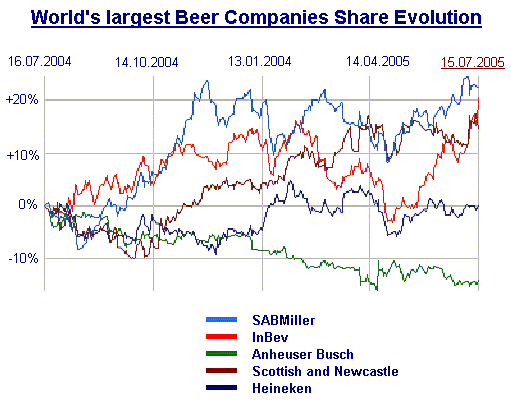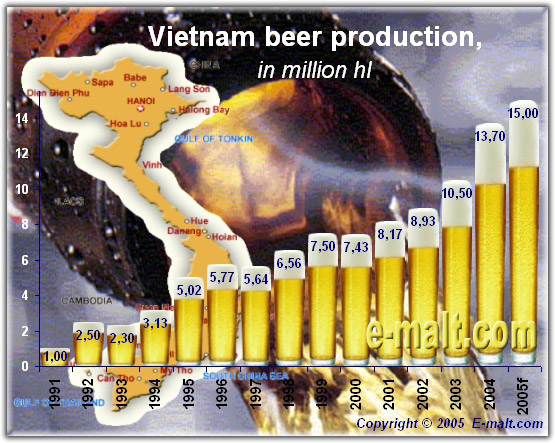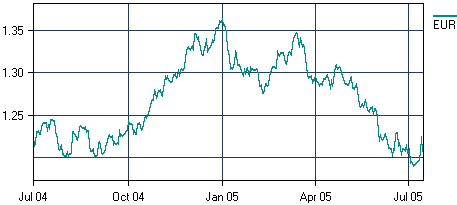 Belgium: InBev realized 104.2 million hl in the first half of 2005
World's beer giant, InBev, announced on July 14 that it realized a total volume of 104.2 million hectoliters in the first six months of 2005
Belgium: InBev realized 104.2 million hl in the first half of 2005
World's beer giant, InBev, announced on July 14 that it realized a total volume of 104.2 million hectoliters in the first six months of 2005, leading to organic volume growth of 5.5% for beer and 4.6% for soft-drinks, totaling 5.4% growth against the same period of last year.
Second quarter beer organic volume growth of 6.3% was markedly stronger than first quarter growth of 4.4%.
In North America, Canadian volumes declined by 1.2%, impacted by Ontario where the discount segment continues to grow, partly offset by good progress in Québec. The US market slowdown led to a 4.3% volume decline, due to the softness of our domestic low-carb brand, Rock Green Light®, and our Canadian brands down by nearly 8%. Our European brands however grew by nearly 12% during the first half.
In Central and South America, beer volumes were up strongly in nearly all countries. In Brazil, beer market share improved 2.0 percentage points over the first half of 2004, reaching 68.3% on the back of 13.3% volume growth.
In Western Europe volumes declined by 4.6% - Benefralux was lower by 3.1%, UK/Ireland declined by 9.7%, while Germany/Italy/Spain/Austria/Switzerland increased by 1.2% on the back of better second quarter volumes.
...
more info
 Czech Republic: Czech beer output increased by 3% in H1 2005
Czech beer production increased by a preliminary 3% in the first-half of 2005
Czech Republic: Czech beer output increased by 3% in H1 2005
Czech beer production increased by a preliminary 3% in the first-half of 2005, chairman of the Czech Association of Breweries and Malt Houses Jan Vesely told CTK on July 13. Exports are estimated to have grown markedly, contributing significantly to the growth in output, Prague Daily Monitor cited Jan Vesely.
Production was higher year-on-year in all months in the January-June period, except for February, which was affected negatively by the long lasting effect of the chilly spell. Full-year beer output is projected to grow to at least 19 million hectolitres, said Vesely.
Last year brewers produced 18.75 million hectolitres of beer, a year-on-year rise of 1.1 %. Domestic output was slightly down, while exports were higher by a quarter at 2.64 million hectolitres.
In January-March of this year, the country exported 560,000 hectolitres of beer, up 15.5 % against the same period last year. Domestic sales dropped almost five percent on the year to 3.26 million hectolitres. CTK news edited by the staff of the Prague Daily Monitor, a Monitor CE service.
 Russia: Baltika Brewery’s share in Russia's total beer exports amounts to 80 %
Russian beer giant, Baltika Brewery, is intending to boost its exports by 20 % in 2005 compared to 2004, the company's press service has recently announced
Russia: Baltika Brewery’s share in Russia's total beer exports amounts to 80 %
Russian beer giant, Baltika Brewery, is intending to boost its exports by 20 % in 2005 compared to 2004, the company's press service has recently announced. In 2004, the company increased its exports by 14% to 1.13 million hl against 2003, and is planning to increase its exports to 1,35 million hl in 2005.
Baltika's export revenue grew by 23 % to USD 50 million in 2004 compared with 2003. The share of exports in Baltika's total sales stood at around 6 %. Baltika exports its products to 38 countries. In 2004, the company hit new markets - China, Australia, Tajikistan, New Zealand, Belgium, Poland, Cyprus, Cuba, and Taiwan, as well as Georgia, Armenia, Norway and Ireland in 2005. In October 2005 Baltika plans to start exports to South Africa and Finland. The company's share in Russia's total beer exports amounted to 80 %.
 Latin America: Beer volumes of Quinsa increased by 8% in H1 2005
Quilmes Industrial (Quinsa) S.A. announced on July 14 its overall beer volumes for the second quarter 2005 increased by 9.4% to 3.02 million hl
Latin America: Beer volumes of Quinsa increased by 8% in H1 2005
Quilmes Industrial (Quinsa) S.A. announced on July 14 its overall beer volumes for the second quarter 2005 increased by 9.4% to 3.02 million hl year-on-year. During the first half of the year to June 2005 Quinsa sold 7.78 million hl of beer: in Argentina 5.30 million hl (+5.9% versus H1 2004); in Bolivia 1.01 million hl (+8.7%); in Chile 219,000 hl (+25%); Paraguay 988,000 hl (+13.9%) and 295,000 hl in Uruguay (+17.7%).
Quinsa is a Luxembourg-based holding company that controls 87.6 percent of Quilmes International (Bermuda) ("QIB"). The remaining 12.4 percent stake is held by Beverage Associates (BAC) Corp. ("BAC") and by Companhia de Bebidas das Americas - AmBev ("AmBev").
Quinsa, through QIB, controls beverage and malting businesses in five Latin American countries. Its beer brands are strong market leaders in Argentina, Bolivia, Paraguay and Uruguay, and have a presence in Chile. Further, pursuant to the Company's strategic alliance with AmBev, it has entered into license and distribution agreements to produce and sell the AmBev brands in Argentina, Bolivia, Paraguay and Uruguay. Similarly, under the agreements, AmBev may produce and distribute Quinsa's brands in Brazil.
The Company also has bottling and franchise agreements with PepsiCo, and thus accounts for 100% of PepsiCo beverage sales in Uruguay and more than 80% of PepsiCo beverage sales in Argentina.
Quinsa's Class A and Class B shares are listed on the Luxembourg Stock Exchange. Quinsa's American Depository Shares, representing the Company's Class B shares, are listed on the New York Stock Exchange.
 China: The country defends its beer against charges it contains cancer-causing agent
The formaldehyde content in one liter of Chinese beer is lower than that in one kilogram of poultry, thus Chinese beer is safe to drink
China: The country defends its beer against charges it contains cancer-causing agent
The formaldehyde content in one liter of Chinese beer is lower than that in one kilogram of poultry, thus Chinese beer is safe to drink, said a report released by the China Brewing Industry Association on July 14, according to Xinhua News Agency. They said domestic beer contained about the same amount of the chemical as imports.
Quoting a recent report from the State Administration of Quality Supervision, Inspection and Quarantine Xinhua News Agency said administration tests on scores of different beer brands showed domestic brews contained up to 0.56 parts per million of formaldehyde, compared to up to 0.61 parts per million for imports.
"Chinese beer is safe to drink as its one-litre formaldehyde content is much lower than the standard set by the World Heath Organization," Xinhua cited the report as saying. The report didn't say which imports had been tested but said the domestic brands tested included best-selling Tsingtao and Yanjing.
Xinhua reported Thursday that one litre of Chinese beer contained, on average, less formaldehyde than one kilogram of chicken, fish or fruit, citing a report from the same government body.
The inspection was prompted by a recent newspaper report claiming 95 per cent of Chinese beers contained formaldehyde, despite the practice being banned by Chinese law.
...
more info
 Barley News
Barley News 
 EU: EU to cut 2005-06 barley export due to Ukrainian competition
The EU is likely to cut its barley exports for the 2005-06 marketing year (October-September) by 300,000 tonnes to 3.3 million tonnes due to an expected hike in Ukraine's barley exports
EU: EU to cut 2005-06 barley export due to Ukrainian competition
The EU is likely to cut its barley exports for the 2005-06 marketing year (October-September) by 300,000 tonnes to 3.3 million tonnes due to an expected hike in Ukraine's barley exports, the US Department of Agriculture said in its July grain trade report.
The USDA said the cut was due to 'greater expected Ukrainian competition at prices necessitating larger E.U. export subsidies.'
Ukraine's 2005-06 barley exports are now seen at 4 million tonnes, up 500,000 tonnes from the earlier forecast due to improved production prospects.
The USDA now sees Ukraine's barley output at 8.5 million tonnes this year, up from an earlier estimate of 8.0 million tonnes. But this year's harvest is expected to drop from the 2004 production of 11.1 million tonnes.
Russia is no longer considered to be a big player on the barley export market, as its exports are seen at around 800,000 tonnes, the lowest level in five years and down from around 1 million tonnes in 2004-05.
 Hops News
Hops News 
 New Zealand: 2005 HOP CROP
The 2005 New Zealand hop harvest was completed in March. The 2004/05 growing season was characterised by a mild Spring
New Zealand: 2005 HOP CROP
The 2005 New Zealand hop harvest was completed in March. The 2004/05 growing season was characterised by a mild Spring followed by a cold and wet early Summer period. From mid January onwards the weather improved and plenty of sunshine ensured a good looking crop. There was an abundance of cones on the vine, with less than the usual number of leaves.
The 2005 yield is an improvement on the previous crop year, and the quality is excellent. Alpha levels were expected to be above average, but on harvest analysis showed closer to average level for the various varieties, which we attribute to the cold and wet early Summer weather.
The crop is currently being processed into pellets and a large portion will be further processed into CO2 hop extract by our JV super-critical extraction company Extract Solutions Ltd.
The majority of the crop is presold, with some surplus hops still available in New Zealand Hallertau Aroma variety and various high alpha hops.















 Currency Rates
Currency Rates 

 Top Industry News
Top Industry News 
 More News
More News 
 Brewery News
Brewery News 









 Belgium: InBev realized 104.2 million hl in the first half of 2005
...
Belgium: InBev realized 104.2 million hl in the first half of 2005
...
 EU: EU to cut 2005-06 barley export due to Ukrainian competition
...
EU: EU to cut 2005-06 barley export due to Ukrainian competition
...
 Australia: Demand for export malt and barley grain is to increase by 60% by 2020
...
Australia: Demand for export malt and barley grain is to increase by 60% by 2020
...